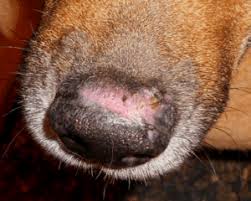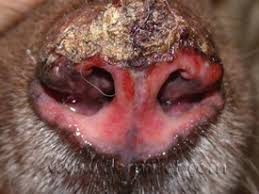Milo the King Charles Cavalier is one of my special patients. He is a beautiful boy with a very big cheeky personality who is sadly deaf but doesn’t let this stop him and much like most dogs living in Queensland enjoys being in the great outdoors.
It was coming to the end of another hot summer when his mum first noticed he had come down with a snuffly cold and a sore, itchy nose. When Milo first presented he indeed had large amounts of gunky snot coming from both nostrils but what made things interesting was where he had once had a fully black nose he now had a pink border where the nose met the skin! The area had become very ulcerated and sore and poor Milo was very uncomfortable and not himself.
 Given this unusual colour change in his nose we knew this wasn’t going to be a straight forward head cold and so Milo was admitted to hospital for the day to undergo a general anaesthetic, so we could take some biopsies of his nose. It was a nice and short procedure for Milo and he went home that afternoon with a few small dissolvable stiches in his nose. Meanwhile his tissue samples were sent to the laboratory to try and figure out what was going on.
Given this unusual colour change in his nose we knew this wasn’t going to be a straight forward head cold and so Milo was admitted to hospital for the day to undergo a general anaesthetic, so we could take some biopsies of his nose. It was a nice and short procedure for Milo and he went home that afternoon with a few small dissolvable stiches in his nose. Meanwhile his tissue samples were sent to the laboratory to try and figure out what was going on.
The border where your dogs black nose meets their normal skin is called the ‘mucocutaneous junction’. This area of tissue is very important as it acts like a ‘glue’ sticking two different tissue types together. The nose is made of a tissue called ‘mucosa’ and has no hair follicles and a classic ‘cobblestone’ appearance. Your dog also has mucocutaneous junctions on their eyelids, lips and the anus. For Milo only his nose was affected, and it was at his mucocutaneous border that we were seeing the odd colour change and ulcerated inflammation. Our biggest concerns when we see changes in this location include autoimmune conditions (Discoid lupus erythema and pemphigus), an infectious disease called Mucocutaneous Pyoderma, Ring worm, Congenital diseases, Zinc deficiencies in Huskies, some cancers and trauma from sticking your nose where it doesn’t belong.
Milo’s nose biopsies were examined by a histopathologist and came back with a diagnosis of Discoid Lupus Erythema (DLE). The biopsies were also tested for bacteria and thankfully came back negative. We now had a diagnosis and could set about making a plan to make Milo better! So, what is Discoid Lupus?
Lupus is an immune-mediated disease where your own immune system attacks your DNA in cells that are broken or have died and are floating about in the body. These dead cells come to lodge in delicate tissue membranes such as the kidney filtration membranes, blood vessel linings, joint capsules and other similar structures. Once caught in these membranes more inflammatory cells are recruited to attack the DNA causing severe inflammatory damage to take place. Generally, when people use the term ‘Lupus’ they are referring to Systemic Lupus (SLE) which can be a very nasty illness and the prognosis is based upon which organs are affected. There is no cure, but symptoms can hopefully be managed with medication. Discoid Lupus (DLE) on the other hand is a more benign form of Lupus limited to only affecting the skin. Thankfully a dog with DLE cannot go on to develop SLE.
 DLE is almost always limited to only affecting the leather of the nose which we call the ‘nasal planum’. Occasionally it can extend up to the bridge of the nose and sometimes affect the ears or the inside of the mouth. Most commonly the first symptoms we see are a colour change or loss of nose pigment. The nose goes from being a black colour to a bluish-grey or even (as in Milo’s case) a pink colour. The nose might also lose its cobblestone pattern in patches and develop a smooth, shiny appearance. As it progresses we will get scaling and cracking of the skin and
DLE is almost always limited to only affecting the leather of the nose which we call the ‘nasal planum’. Occasionally it can extend up to the bridge of the nose and sometimes affect the ears or the inside of the mouth. Most commonly the first symptoms we see are a colour change or loss of nose pigment. The nose goes from being a black colour to a bluish-grey or even (as in Milo’s case) a pink colour. The nose might also lose its cobblestone pattern in patches and develop a smooth, shiny appearance. As it progresses we will get scaling and cracking of the skin and  eventually the nose will ulcerate. Exposure to sunshine makes the condition worse and therefore we see it a lot in Queensland.
eventually the nose will ulcerate. Exposure to sunshine makes the condition worse and therefore we see it a lot in Queensland.
As in Milos case skin biopsies are the only way to get a diagnosis which is crucial for helping your vet to decide what treatment is indicated. Sadly DLE is for life, but for many pets once we have controlled the initial inflammation and the nose has returned to a normal appearance, we can look at reducing their medications. In some dogs they can come off their medications all together, with owners only needing to restart when the first sign of colour change in the nose is seen.
As this disease is exacerbated by sunlight we advised that Milo be kept out of the hot sun in the middle of the day. You can also purchase special dog hats with visors to shade the nose or get doggy sunscreen to try and help limit the effect of the sun on the nose. It is important to remember there are many toxic ingredients in human sunscreen that should not be ingested by dogs. Given the location of DLE it is expected that some of the sunscreen will be licked away and therefore pet sunscreens are made with this in mind.
Milo was also started on a combination of:
- PAW Dermega oil – a liquid omega supplement for dogs. It combines both the omega 3’s for anti-inflammatory, with the plant-based omega 6’s to keep the skin soft and healthy
- Niacinamide (Vitamin B3) – has a wide range of functions that help the skin to function as a healthy organ with good defence barriers
- Doxycycline antibiotic – as well as killing bacteria this antibiotic has immune modulating properties which when used in conjunction with the Vitamin B3 are found to be highly successful in treating DLE
After 3 weeks Milo had improved slightly but was still uncomfortable, so we added in Corticosteroids to his treatment plan. We use steroids to reduce inflammation by dampening down the immune response of the body. For most dogs with DLE steroids are not necessary but this is a disease that is quite individual and for Milo he had quite a severe case.
3 months after diagnosis and Milo’s nose is now back to its healthy black cobblestone appearance. He is no longer snuffly or itchy but will have to remain on his medication for a while longer before we will know if he can stop his medication.
Case Solved!

